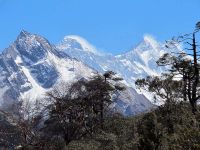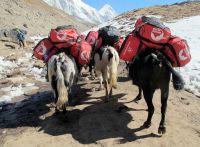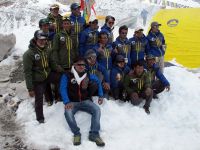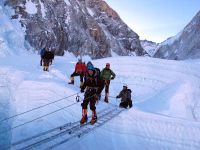Another bad year on Everest
When the dust settled on the Everest tragedy of April 18th 2014 and I finished my shift helping the doctors at the 'Everest ER' Base Camp clinic I could not imagine that I would be doing the same job helping to look after the dead and injured just one year later.
Just before noon on April 25th 2015 I was walking on the trail between Gorak Shep and Everest Base Camp, a distance of about 5km. Half way along the trail the ground beneath my feet began to shake. At first I thought that a serac fall or avalanche had happened nearby and we were feeling the reverberations. As the tremor continued I realised that the cause was an earthquake. Some small stones began to fall down the hillside behind me and I took shelter behind a large rock. A few moments later I was engulfed in a cloud of snow as an avalanche from Nuptse on the East side of the valley swept across the trail. This deposited a few centimetres of snow and caused a fair bit of panic amongst trekkers making their way towards Base Camp.
I continued walking to Base Camp which occupies a large area, spread along more than 1km of the Khumbu glacier. When I reached the first camps (IMG, HimEx, Asian Trekking) everything seemed normal and there was no sign that the earthquake had caused any damage. As I progressed along the trail I began to see people covered in blood walking towards me and I realised that something had happened in the middle section of camp.
The quake had released a large ice cliff from the peak of Pumori to the West of Base Camp and this had resulted in a powerful avalanche destroying the camps of several expeditions. The worst affected teams were those camped at the western side of the BC 'strip' including Himalayan Guides, the UK Gurkha 200 expedition, and Adventure Consultants. All their BC tents and equipment had been blown over by the force of the avalanche and buried under 10-50cm of snow. Several other expeditions, including my own, suffered the blast and had tents blown several hundred meters away, but were not buried under so much snow.
In total 7-8 expeditions were badly affected. The avalanche had been powerfully concentrated onto the central section of Base Camp, while expeditions at the 'top' and 'bottom' ends of camp suffered very little damage. Many of the climbers from the worst affected expeditions were on the mountain at Camps 1 & 2. The majority of the casualties at Base Camp were kitchen staff and Sherpas. People in Base Camp had felt the initial quake and most had come out of their tents. There had then been very little warning before the avalanche hit. Some people had been able to take shelter behind rocks, others had been caught in the open as they tried to run for shelter.
My own expedition Base Camp was totally destroyed. All 20 of the sleeping tents for climbers and Sherpas had been blown away, together with their contents, and some were lying 50-100m away. The large dining tent, 3 store tents, Sherpa kitchen, Sherpa dining tent, and the office tent were flattened and their contents scattered over a wide area. The kitchen tent was partially standing but everything inside was on the ground and broken.
In the 40 minutes it had taken me to walk to BC Chris Groves had taken charge of the situation assessing the scale of injuries and damage in the Jagged Globe camp. Four Sherpas had been injured and taken to the Everest ER clinic for treatment. One climber had been blown 40m by the blast and sustained fatal head injuries when colliding with a large rock. Two other climbers sustained serious injuries requiring urgent treatment from the doctors at the clinic, and one climber was badly bruised and shaken. I left Chris in charge of camp (keeping everyone warm and comfortable, preparing camp for the night ahead, looking for lost equipment, etc).
I went to the Everest ER clinic to assist with assessing and treating patients. The clinic tent had been badly damaged by the avalanche. Medicines and supplies lay scattered on the floor, there were gaping holes in the walls and the 3 beds were occupied by patients. Throughout the afternoon a steady stream of injured people arrived at the clinic as new victims were found among the debris of camp. While the 3 doctors treated the injured I worked with two other guides to organise the transport of patients between the triage site at the clinic and the treatment centre that had been established at the undamaged IMG camp.
Sherpas and climbers from many teams helped in the rescue effort. More than a hundred people helped to carry patients on stretchers from the clinic to the IMG camp, a difficult journey of more than 30 minutes over uneven and slippery ground. Other teams close to the accident site provided sleeping bags and bottles of hot water for patients. By the late afternoon those with minor injuries had been treated and provided with shelter. The most seriously injured were receiving ongoing treatment and would be looked after overnight pending helicopter evacuation the following morning. The dead had been identified and prepared for transportation to Kathmandu when helicopters became available. Before nightfall the doctors were able to abandon the damaged clinic tent and move together with their supplies and equipment to the IMG camp, where the large dining tent had been converted to a hospital tent.
Helicopters were able to fly the following day. The dead and injured were flown from Base Camp to Kathmandu. At the time we believed that the total number of dead at BC to be around 15, although the final number rose to 19 in the following days. As news began to filter into BC the climbers became aware of the scale of destruction elsewhere in Nepal. The epicentre of the quake had been west of Kathmandu, and the loss of life and damage in that area far worse than in the Everest region.
It quickly became apparent that the climbing season would not continue and climbers began to leave Base Camp for the trek to Lukla and flight to Kathmandu. I remained in camp for a few days helping the Sherpas to collect and sort all the broken and damaged equipment in our camp. Our team collected more than 3,000kg and gave this to the SPCC for disposal.
On the trek down the Khumbu valley I was pleasantly surprised how little damage there was. All the trails and bridges were intact as were most buildings in the main villages of Pheriche, Pangboche, Namche Bazaar and Lukla. Some older buildings have collapsed or been seriously damaged, but of the tourist lodges and newer private houses more than 80% were either undamaged or had suffered only minor damage that will be easily repaired before the autumn trekking season. I did not visit the villages of Thame or Khumjung where I believe the situation is worse. As far as I know there were four fatalities amongst the local population numbering several thousand in the Khumbu region.
In April 2014 the eyes of the world’s media were on Everest and climbers and Sherpas were at the centre of the story. In 2015 the earthquake in Nepal caused widespread damage and loss of life in large parts of the country. With thousands killed and hundreds of thousands homeless the events on Everest were no more than a footnote to the main story.
A large international relief effort has been mobilised to help Nepal recover from the immediate after effects of the earthquake. In the longer term large amounts of reconstruction aid will be required. However the people that I talked to working in the tourism industry were keen to say that Nepal would be open for business in the autumn season, and that best way for friends of Nepal to help in the coming years was to encourage the rapid resumption of inbound tourism.
Written mostly in Lukla on May 2nd 2015 – David Hamilton




















